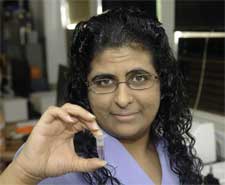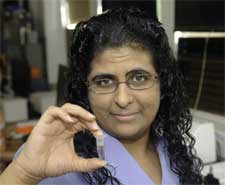 Sole professor to win nationwide award
Sole professor to win nationwide award
KINGSTON, R.I. –August 13, 2009—Some day it may be possible to detect the tiniest trace pollutants in water and remediate them before a small problem becomes a big one.
Radha Narayanan of Hopkinton, an assistant professor of chemistry at the University of Rhode Island, is helping to pave the road to that reality.
Her research proposal so impressed the Society for Analytical Chemists of Pittsburgh that it awarded Narayanan its $40,000 starter grant.
The award is given to only one assistant professor nationwide whose proposed research has considerable scientific merit and the likelihood of making a significant positive impact on graduate students and the field of analytical chemistry. The award is given to a junior faculty member within the first six years of his or her professional career. Narayanan just completed her first year at URI.
The professor works with graduate students Kalyani Gude and Susmita Kapavarapu, and undergraduate student Benjamin Saute. She will be working with additional graduate and undergraduate students this fall.
“We are particularly proud to see one of our junior female faculty members receive this award,” said Winifred Brownell, dean of the College of Arts and Sciences.
“Professor Narayanan came to URI with an international reputation in the study of gold nanoparticles,” says William Euler, chair of URI’s Chemistry Department. “Now she is applying her expertise to an important environmental problem, which is the basis for this prestigious recognition.”
While Narayanan thinks big, as Euler notes, she works with nanoparticles. How tiny is that? One billion nanometers are equal to one meter. Her particles range from one to 100 nanometers.
She employs Surface Enhanced Raman Spectroscopy, or Surface Enhanced Raman Scattering, often-abbreviated SERS. It is a technique that enhances scattering of molecules adsorbed on rough metal surfaces. The high enhancement factor allows the technique to be sensitive enough to detect a single molecule.
In the process, Narayanan will synthesize gold nanoparticles of different shapes that are suspended in a watery solution. When a drop of tainted water is added, the molecules will bind to the gold nanoparticles and produce a quantitative readout of any environmental pollutant. The goal is to develop a fast and sensitive solution-based direct readout method to detect the environmental pollutants in water.
This early detection and eventual remediation process is particularly important for business, utilities and others required to meet federal Environmental Protection Agency standards and local health codes.
URI Department of Communications & Marketing photo by Michael Salerno Photography.

